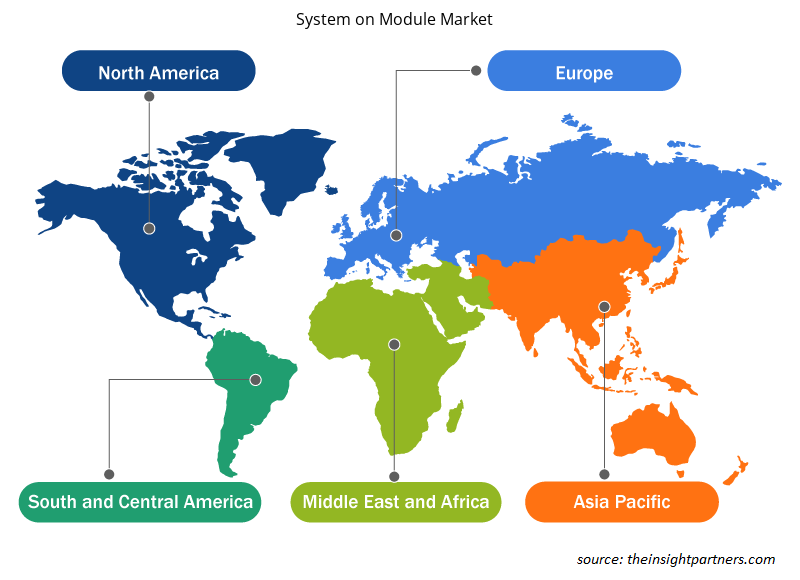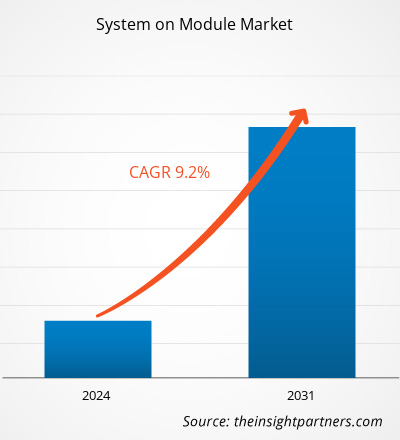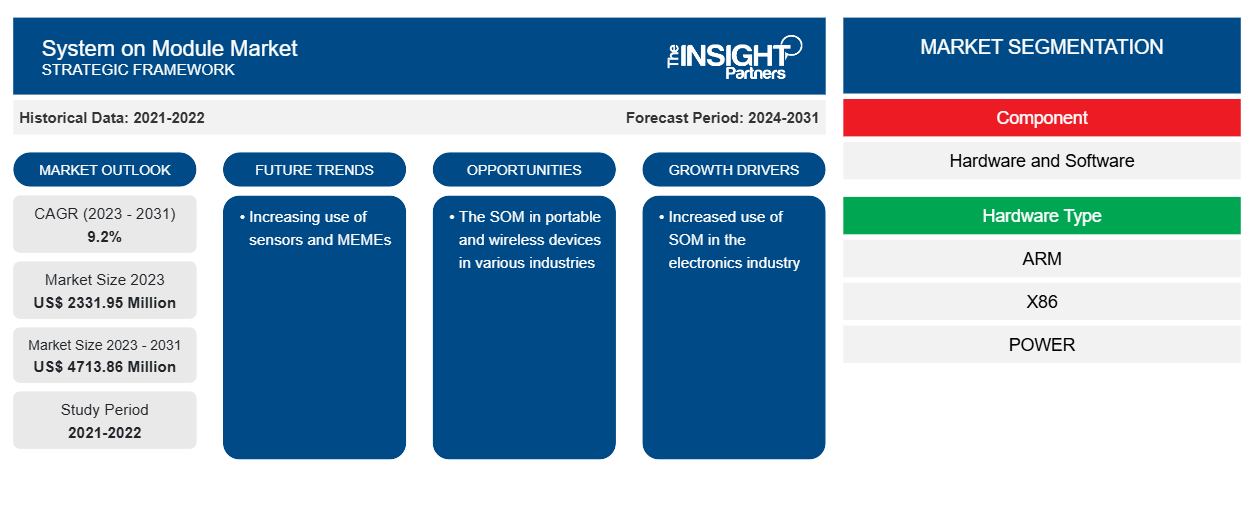Der Markt für Systemmodule soll von 2331,95 Millionen US-Dollar im Jahr 2023 auf 4713,86 Millionen US-Dollar im Jahr 2031 anwachsen. Der Markt wird zwischen 2023 und 2031 voraussichtlich eine durchschnittliche jährliche Wachstumsrate (CAGR) von 9,2 % verzeichnen. Die zunehmende Nutzung von Sensoren und MEMEs dürfte ein wichtiger Trend auf dem Markt bleiben.
System-on-Module-Marktanalyse
Der weltweite Lockdown zur Eindämmung der Virusübertragung hat die Lieferkettenaktivitäten und Produktionskapazitäten mehrerer Hersteller, insbesondere kleiner und mittlerer Unternehmen, erheblich beeinträchtigt. Die Halbleiterindustrie trug maßgeblich zur Nachfrage des Industriesektors und der Endverbraucher nach elektronischen Komponenten bei. Das Umsatzmodell für Mikroelektronik ist aufgrund der fehlenden Massenproduktion während des Lockdowns zurückgegangen. Die Halbleiterindustrie konnte allmählich Marktanteile zurückgewinnen, als die Produktionsanlagen unter Einhaltung von Maßnahmen zur sozialen Distanzierung ihren Betrieb wieder aufnahmen. Darüber hinaus steigerten Strategien zur Heimarbeit und Fernüberwachung auch den Verkauf fortschrittlicher Elektronikprodukte für eine verbesserte Konnektivität. Die Bedeutung der IT- und Telekommunikationsbranche wurde für Kommunikationszwecke hervorgehoben, was die Weiterentwicklung der Branche mit neuen Technologien wie Wi-Fi-kompatibler Hochgeschwindigkeits-Verpackungstechnologie bestätigte.
System-on-Module-Marktübersicht
Ein System-on-Module (SOM) stellt die Kernkomponenten eines eingebetteten Verarbeitungssystems wie Speicherblöcke, Kommunikationsschnittstellen und Prozessorkerne auf einer einzigen produktionsbereiten Leiterplatte (PCB) dar. Dieser modulare Ansatz macht ein SOM für die Einbettung in Endsysteme geeignet, von Robotern bis hin zu Überwachungskameras . Das Konzept der System-on-Module entwickelte sich aus Blade-Servern. Diese schlanken Server wurden entwickelt, um Speicherplatz zu sparen und den Stromverbrauch zu senken. Die Architektur von SOMs beeinflusst die Lean-Design-Mentalität hinter Blade-Servern. Sie enthalten nur die für ihre beabsichtigte Funktion erforderlichen Komponenten in einem möglichst kleinen Paket und sind flexibel genug, um für eine breite Palette von Anwendungen geeignet zu sein.
Passen Sie diesen Bericht Ihren Anforderungen an
Sie erhalten kostenlos individuelle Anpassungen an jedem Bericht, einschließlich Teilen dieses Berichts oder einer Analyse auf Länderebene, eines Excel-Datenpakets sowie tolle Angebote und Rabatte für Start-ups und Universitäten.
-
Holen Sie sich die wichtigsten Markttrends aus diesem Bericht.Dieses KOSTENLOSE Beispiel umfasst eine Datenanalyse von Markttrends bis hin zu Schätzungen und Prognosen.
Treiber und Chancen auf dem System-on-Module-Markt
Verstärkter Einsatz von SOM in der Elektronikindustrie
Als flexible Kernkomponenten ermöglichen SOMs eine schnelle Entwicklung in verschiedenen technologischen Anwendungen, von der Unterhaltungselektronik bis zur industriellen Automatisierung, und sind daher im modernen Produktdesign unverzichtbar. In der sich schnell entwickelnden Umgebung des elektronischen Produktdesigns hat sich die System-on-Module-Methode (SoM) als Schlüsselquelle der Transformation herausgestellt. Aufgrund seiner kompakten Größe, hohen Leistung und Kosteneffizienz wird SoM bei Designern und Ingenieuren immer beliebter. Daher treibt der zunehmende Einsatz von SOM in der Elektronikindustrie das Marktwachstum voran.
Das SOM in tragbaren und drahtlosen Geräten in verschiedenen Branchen
SoMs werden in tragbaren medizinischen Geräten verwendet, bei denen Zuverlässigkeit und Kompaktheit von entscheidender Bedeutung sind. Beispielsweise kann ein SoM in ein tragbares Ultraschallgerät integriert werden und die erforderliche Verarbeitungsleistung und Konnektivität in einem kompakten Formfaktor bereitstellen. SoMs werden in fortschrittlichen Fahrerassistenzsystemen (ADAS) eingesetzt, wo sie die für die Echtzeitverarbeitung von Sensordaten erforderlichen Hochleistungsrechenfunktionen bereitstellen. In industriellen Umgebungen werden SoMs in speicherprogrammierbaren Steuerungen (SPS) und Mensch-Maschine-Schnittstellen (HMIs) verwendet und bieten robuste und skalierbare Lösungen für komplexe Automatisierungsaufgaben.
Segmentierungsanalyse des System-on-Module-Marktberichts
Wichtige Segmente, die zur Ableitung der System-on-Module-Marktanalyse beigetragen haben, sind Komponente, Hardwaretyp und Anwendung.
- Basierend auf der Komponente wird das System auf dem Modulmarkt in Hardware und Software unterteilt. Das Segment der Standard-Prüfkarten hatte im Jahr 2023 einen größeren Marktanteil.
- Nach Hardwaretyp ist der Markt in Arm, X86, POWER, FPGA, GPU, DSP und RISC-V segmentiert. Das oberflächenmontierte Segment hatte im Jahr 2023 einen größeren Marktanteil.
- Nach Anwendung ist der Markt in industrielle Automatisierung, Unterhaltung, Medizin, Transport, Test und Messung, Videoanwendungen und Andere segmentiert.
System-on-Module-Marktanteilsanalyse nach Geografie
Der geografische Umfang des Marktberichts zum Systemmodul ist hauptsächlich in fünf Regionen unterteilt: Nordamerika, Asien-Pazifik, Europa, Naher Osten und Afrika sowie Süd- und Mittelamerika.
APAC dominiert den System-on-Module-Markt. Viele der APAC-Länder sind durch die Menge an elektronischen Geräten gekennzeichnet, die für Automobilkomponenten, Telekommunikationsgeräte, Unterhaltungselektronik und andere Arten von Industriemaschinen benötigt werden. Die wachsende Zahl von Elektronikherstellern in China und Indien, die auf die gute Verfügbarkeit von qualifizierten Arbeitskräften zurückzuführen ist, treibt den System-on-Module-Markt voran.
Regionale Einblicke in den System-on-Module-Markt
Die regionalen Trends und Faktoren, die den System-on-Module-Markt während des Prognosezeitraums beeinflussen, wurden von den Analysten von Insight Partners ausführlich erläutert. In diesem Abschnitt werden auch die Marktsegmente und die Geografie des System-on-Module-Marktes in Nordamerika, Europa, im asiatisch-pazifischen Raum, im Nahen Osten und Afrika sowie in Süd- und Mittelamerika erörtert.

- Erhalten Sie regionale Daten zum System-on-Module-Markt
Umfang des System-on-Module-Marktberichts
| Berichtsattribut | Details |
|---|---|
| Marktgröße im Jahr 2023 | 2331,95 Millionen US-Dollar |
| Marktgröße bis 2031 | 4713,86 Millionen US-Dollar |
| Globale CAGR (2023 - 2031) | 9,2 % |
| Historische Daten | 2021-2022 |
| Prognosezeitraum | 2024–2031 |
| Abgedeckte Segmente |
Nach Komponente
|
| Abgedeckte Regionen und Länder |
Nordamerika
|
| Marktführer und wichtige Unternehmensprofile |
|
Dichte der Marktteilnehmer für System-on-Module: Auswirkungen auf die Geschäftsdynamik verstehen
Der Markt für System-on-Module-Systeme wächst rasant. Dies wird durch die steigende Nachfrage der Endnutzer aufgrund von Faktoren wie sich entwickelnden Verbraucherpräferenzen, technologischen Fortschritten und einem größeren Bewusstsein für die Vorteile des Produkts vorangetrieben. Mit der steigenden Nachfrage erweitern Unternehmen ihr Angebot, entwickeln Innovationen, um die Bedürfnisse der Verbraucher zu erfüllen, und nutzen neue Trends, was das Marktwachstum weiter ankurbelt.
Die Marktteilnehmerdichte bezieht sich auf die Verteilung der Firmen oder Unternehmen, die in einem bestimmten Markt oder einer bestimmten Branche tätig sind. Sie gibt an, wie viele Wettbewerber (Marktteilnehmer) in einem bestimmten Marktraum im Verhältnis zu seiner Größe oder seinem gesamten Marktwert präsent sind.
Die wichtigsten auf dem System-on-Module-Markt tätigen Unternehmen sind:
- Mikrochip-Technologie
- Einschl.
- Advantech Co. Ltd.
- SoMLabs
- Axiomtek Co. Ltd.
- Kontaktieren Sie uns
Haftungsausschluss : Die oben aufgeführten Unternehmen sind nicht in einer bestimmten Reihenfolge aufgeführt.

- Überblick über die wichtigsten Akteure auf dem System-on-Module-Markt
System-on-Module-Marktnachrichten und aktuelle Entwicklungen
Das System auf dem Modulmarkt wird durch die Erhebung qualitativer und quantitativer Daten nach Primär- und Sekundärforschung bewertet, die wichtige Unternehmensveröffentlichungen, Verbandsdaten und Datenbanken umfasst. Nachfolgend sind einige der Entwicklungen im System auf dem Modulmarkt aufgeführt:
- Toradex, ein führender Anbieter eingebetteter Systemlösungen, hat seine neueste Familie pinkompatibler und skalierbarer Systems on Modules (SoMs) auf den Markt gebracht – Aquila. (Quelle: Toradex, Pressemitteilung, April 2024)
- NetBurner hat die Markteinführung seiner neuesten Lösung angekündigt, des System-on-Module (SOM) SOMRT1061. Mit seiner Leistung in einer kleinen Größe von 25,4 mm eignet es sich ideal für den Einsatz als Hauptsystemprozessor, Netzwerk-Subprozessor oder sogar als verschlüsselter Seriell-zu-Ethernet-Server. (Quelle: NetBurner, Pressemitteilung, Mai 2024)
Abdeckung und Ergebnisse des System-on-Module-Marktberichts
Der Bericht „Marktgröße und Prognose für System-on-Module (2021–2031)“ bietet eine detaillierte Analyse des Marktes, die die folgenden Bereiche abdeckt:
- System-on-Module-Marktgröße und -prognose auf globaler, regionaler und Länderebene für alle wichtigen Marktsegmente, die im Rahmen des Projekts abgedeckt sind
- System-on-Module-Markttrends sowie Marktdynamik wie Treiber, Einschränkungen und wichtige Chancen
- Detaillierte PEST/Porters Five Forces- und SWOT-Analyse
- System-on-Module-Marktanalyse, die wichtige Markttrends, globale und regionale Rahmenbedingungen, wichtige Akteure, Vorschriften und aktuelle Marktentwicklungen umfasst
- Branchenlandschaft und Wettbewerbsanalyse, einschließlich Marktkonzentration, Heatmap-Analyse, prominenten Akteuren und aktuellen Entwicklungen für den System-on-Module-Markt
- Detaillierte Firmenprofile
- Historische Analyse (2 Jahre), Basisjahr, Prognose (7 Jahre) mit CAGR
- PEST- und SWOT-Analyse
- Marktgröße Wert/Volumen – Global, Regional, Land
- Branchen- und Wettbewerbslandschaft
- Excel-Datensatz
Aktuelle Berichte
Erfahrungsberichte
Grund zum Kauf
- Fundierte Entscheidungsfindung
- Marktdynamik verstehen
- Wettbewerbsanalyse
- Kundeneinblicke
- Marktprognosen
- Risikominimierung
- Strategische Planung
- Investitionsbegründung
- Identifizierung neuer Märkte
- Verbesserung von Marketingstrategien
- Steigerung der Betriebseffizienz
- Anpassung an regulatorische Trends























 Kostenlose Probe anfordern für - System auf dem Modulmarkt
Kostenlose Probe anfordern für - System auf dem Modulmarkt